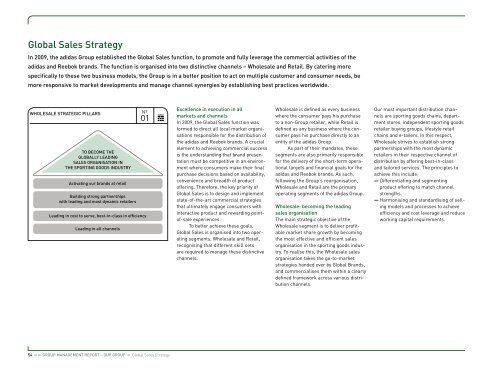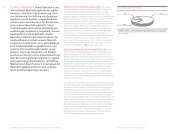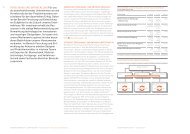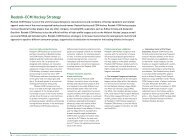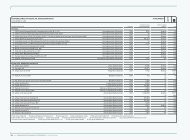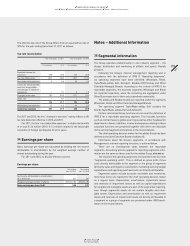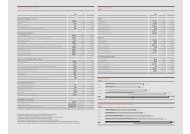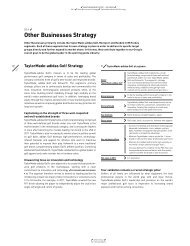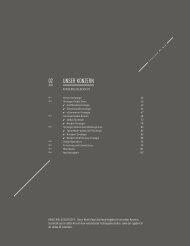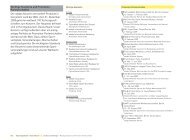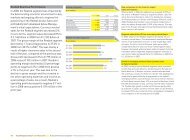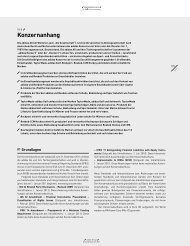You also want an ePaper? Increase the reach of your titles
YUMPU automatically turns print PDFs into web optimized ePapers that Google loves.
<strong>Global</strong> <strong>sales</strong> <strong>strategy</strong><br />
in 2009, the adidas Group established the <strong>Global</strong> <strong>sales</strong> function, to promote and fully leverage the commercial activities of the<br />
adidas and reebok brands. the function is organised into two distinctive channels – wholesale and retail. By catering more<br />
specifically to these two business models, the Group is in a better position to act on multiple customer and consumer needs, be<br />
more responsive to market developments and manage channel synergies by establishing best practices worldwide.<br />
wHolEsalE stratEGic Pillars<br />
to BEcomE tHE<br />
GloBally lEadinG<br />
salEs orGanisation in<br />
tHE sPortinG Goods industry<br />
activating our brands at retail<br />
Building strong partnerships<br />
with leading and most dynamic retailers<br />
N°-<br />
01<br />
leading in cost to serve, best-in-class in efficiency<br />
leading in all channels<br />
54 GrouP manaGEmEnt rEPort – our GrouP <strong>Global</strong> Sales Strategy<br />
Excellence in execution in all<br />
markets and channels<br />
In 2009, the <strong>Global</strong> Sales function was<br />
formed to direct all local market organisations<br />
responsible for the distribution of<br />
the adidas and Reebok brands. A crucial<br />
element to achieving commercial success<br />
is the understanding that brand presentation<br />
must be competitive in an environment<br />
where consumers make their final<br />
purchase decisions based on availability,<br />
convenience and breadth of product<br />
offering. Therefore, the key priority of<br />
<strong>Global</strong> Sales is to design and implement<br />
state-of-the-art commercial strategies<br />
that ultimately engage consumers with<br />
interactive product and rewarding pointof-sale<br />
experiences.<br />
To better achieve these goals,<br />
<strong>Global</strong> Sales is organised into two operating<br />
segments, Wholesale and Retail,<br />
recognising that different skill sets<br />
are required to manage these distinctive<br />
channels.<br />
Wholesale is defined as every business<br />
where the consumer pays his purchase<br />
to a non-Group retailer, while Retail is<br />
defined as any business where the consumer<br />
pays his purchase directly to an<br />
entity of the adidas Group.<br />
As part of their mandates, these<br />
segments are also primarily responsible<br />
for the delivery of the short-term operational<br />
targets and financial goals for the<br />
adidas and Reebok brands. As such,<br />
following the Group’s reorganisation,<br />
Wholesale and Retail are the primary<br />
operating segments of the adidas Group.<br />
wholesale: becoming the leading<br />
<strong>sales</strong> organisation<br />
The main strategic objective of the<br />
Wholesale segment is to deliver profitable<br />
market share growth by becoming<br />
the most effective and efficient <strong>sales</strong><br />
organisation in the sporting goods industry.<br />
To realise this, the Wholesale <strong>sales</strong><br />
organisation takes the go-to-market<br />
strategies handed over by <strong>Global</strong> Brands,<br />
and commercialises them within a clearly<br />
defined framework across various distribution<br />
channels.<br />
Our most important distribution channels<br />
are sporting goods chains, department<br />
stores, independent sporting goods<br />
retailer buying groups, lifestyle retail<br />
chains and e-tailers. In this respect,<br />
Wholesale strives to establish strong<br />
partnerships with the most dynamic<br />
retailers in their respective channel of<br />
distribution by offering best-in-class<br />
and tailored services. The principles to<br />
achieve this include:<br />
Differentiating and segmenting<br />
product offering to match channel<br />
strengths.<br />
Harmonising and standardising of selling<br />
models and processes to achieve<br />
efficiency and cost leverage and reduce<br />
working capital requirements.
customer and range segmentation<br />
to drive effectiveness<br />
Rolling out standardised product<br />
range packages around the globe is an<br />
important part of the Group’s wholesale<br />
<strong>strategy</strong>. The initiative, which was first<br />
designed and implemented in Europe,<br />
involves a customer segmentation<br />
<strong>strategy</strong> that facilitates the systematic<br />
allocation of differentiated product packages<br />
to groups of comparable customers.<br />
This segmentation is broadly based on a<br />
distinction between sports and lifestyle<br />
retailers that either have an up-market<br />
“brand-driven” positioning or a valueoriented<br />
“commercial” positioning. By<br />
best suiting their specific needs, this<br />
provides <strong>Global</strong> Sales a platform to<br />
better exploit market potential, while at<br />
the same time supporting the reduction<br />
of complexity and costs. In addition,<br />
Wholesale continues to partner with<br />
retailers on increasing the level and<br />
quality of sell-through information the<br />
Group receives. This creates a mutually<br />
beneficial understanding of their needs<br />
that will help the Group become a more<br />
valuable and reliable business partner to<br />
our retailers, driving incremental business<br />
opportunities.<br />
retail space management to<br />
drive efficiency<br />
Retail Space Management (RSM) comprises<br />
all business models helping <strong>Global</strong><br />
Sales to expand controlled space in retail.<br />
The Wholesale function is cooperating<br />
with retailers along the entire supply<br />
chain to bring best-in-class service all<br />
the way through to the point of sale. By<br />
helping to improve the profitability per<br />
square metre for the Group’s retail partners<br />
as well as improving product availability,<br />
we can achieve higher customer<br />
satisfaction, thus driving share of retail<br />
shelf space.<br />
The three predominant models to<br />
drive the success of RSM for the adidas<br />
Group are Never-out-of-stock, FLASH<br />
collections and Franchising.<br />
never-out-of-stock (noos): The NOOS<br />
programme comprises a core range<br />
of basic articles, mostly on an 18 – 24<br />
months lifecycle, that are selling across<br />
all channels and markets. Overall, the<br />
NOOS replenishment model secures high<br />
levels of product availability throughout<br />
the season, allowing for quick adaptation<br />
to demand patterns. Retailers have to<br />
provide dedicated retail space, co-invest<br />
in fixtures and fittings and commit to a<br />
“first fill” representing about 25% of total<br />
expected seasonal demand to participate<br />
in this programme. In return, customers<br />
can profit from significantly reduced<br />
inventory risk on these products. Most<br />
NOOS articles are on an end-to-end<br />
supply chain, thus limiting the adidas<br />
Group’s inventory risk as we re-produce<br />
following customer demand.<br />
FlasH collections: The FLASH programme<br />
consists of pre-defined collection<br />
packages that are delivered every<br />
4 – 6 weeks to retailers’ doors, including<br />
basic point-of-sale promotional materials<br />
to promote dedicated retail space<br />
provided by the retailer. All articles of the<br />
FLASH packages are exclusively developed<br />
for this programme with the intention<br />
to bring freshness to the retail space.<br />
With a short development lead time, we<br />
are able to reflect recent product and<br />
colour trends in the FLASH range. As no<br />
samples are available during sell-in, the<br />
customers buy into a business proposition<br />
rather than traditionally selecting<br />
individual articles. In return for this<br />
commitment, the retailers have the right<br />
to selectively return articles of every<br />
FLASH collection that have not sold out<br />
during the defined retail window. Overall,<br />
the FLASH programme helps to improve<br />
brand image while limiting inventory<br />
risk for the customers. The FLASH programme<br />
has been started in 2010, with<br />
full-scale rollout planned from 2012<br />
onwards.<br />
Franchising: Mono-branded store<br />
franchising is one of the Group’s prime<br />
growth opportunities, as it offers superior<br />
brand presentation. Franchise stores are<br />
financed and operated by franchise partners.<br />
The adidas Group normally contributes<br />
to the costs for brand- specific<br />
fixtures and fittings each store has to be<br />
equipped with.<br />
Further, we support our franchise<br />
partners with a comprehensive franchise<br />
concept, including range propos itions,<br />
IT systems, training concepts, and<br />
guidelines for store building and store<br />
operations. This ensures that the quality<br />
of the brand presentation and the service<br />
offered to the consumer are at all times<br />
high and comparable to our own retail<br />
stores.<br />
Harmonisation and standardisation<br />
of processes to exploit leverage<br />
While understanding that market and<br />
consumer needs require differentiated<br />
distribution policies, the establishment<br />
of the <strong>Global</strong> Sales function is also an<br />
enabler to further leverage the size of<br />
our Group and reduce complexity by<br />
implementing best operational practices<br />
across our wholesale activities. The harmonisation<br />
and standardisation particularly<br />
of back-end processes can help to<br />
further reduce cost through simplified<br />
IT systems and applications. Similarly,<br />
and already started in Europe, we are<br />
rolling out a trade terms policy that<br />
rewards customer performance either<br />
by higher efficiency (e.g. in logistics) or<br />
better sell-out support (e.g. by point-ofsale<br />
activation). As part of this effort we<br />
will harmonise trade terms definitions,<br />
and we have established regular reporting,<br />
delivering meaningful benchmarks<br />
that allow us to tightly control our<br />
investments.<br />
GrouP manaGEmEnt rEPort – our GrouP <strong>Global</strong> Sales Strategy 55
Etail stratEGic Pillars<br />
N°-<br />
02<br />
to BEcomE a<br />
toP rEtailEr By dElivErinG<br />
HEaltHy, sustainaBlE GrowtH<br />
witH outstandinG rEturn on invEstmEnt<br />
Focus on consumers<br />
achieve operational excellence<br />
Exploit portfolio of brands<br />
leverage global presence and scale<br />
56 GrouP manaGEmEnt rEPort – our GrouP <strong>Global</strong> Sales Strategy<br />
retail: becoming one of the top<br />
retailers in the world<br />
Our strategic vision for Retail is to<br />
become one of the top retailers in the<br />
world by delivering healthy, sustainable<br />
growth with outstanding return on<br />
investment. Over the past five years,<br />
the adidas Group has evolved into a<br />
significant retailer, operating more that<br />
2,200 stores for the adidas and Reebok<br />
brands worldwide. In light of the increase<br />
in importance of retail to the Group’s<br />
performance, a new retail leadership<br />
team was established in 2009. This team<br />
is mandated to create global retail guidelines<br />
that enable higher efficiency and a<br />
common framework to drive long-term<br />
profitability for the adidas and Reebok<br />
retail operations around the globe.<br />
To become a more successful<br />
retailer, Retail has defined four strategic<br />
pillars:<br />
focus on the consumer,<br />
achieve operational excellence,<br />
exploit Retail’s portfolio of brands,<br />
leverage the Group’s global presence<br />
and scale.<br />
To execute on these pillars, Retail has set<br />
its strategic priorities around improving<br />
its delivery on the five P’s of retail.<br />
People<br />
The consumer and our employees<br />
are the primary reference points for<br />
Retail’s business model. Retail constantly<br />
strives to interpret and adapt to<br />
consumer demand, targeting a mix of<br />
new and loyal consumers, whether it be<br />
sports-active, sports-inspired or casual<br />
consumers. A focus area for development<br />
in this respect is the creation of<br />
loyalty programmes that are attractive<br />
to the various consumer groups of our<br />
brands. To make sure that consumer<br />
needs are being met, Retail will set up<br />
organisational teams and recruit store<br />
staff that are passionate, knowledgeable<br />
and whose highest priority is to serve<br />
the consumer.<br />
Products<br />
The key element of Retail’s product<br />
<strong>strategy</strong> is to ensure that relevant products<br />
are presented through the Group’s<br />
various retail formats to match the<br />
intended consumer profile. This requires<br />
a product offering that needs to be pricecompetitive,<br />
simple to understand, easy<br />
to find and, most importantly, available<br />
at the right time and at the right place.<br />
To achieve this goal, Retail will leverage<br />
the product assortments, concepts and<br />
point-of-sale materials provided by<br />
<strong>Global</strong> Brands in an effort to match realtime<br />
consumer trends.<br />
Premises<br />
The start of a pleasant shopping experience<br />
is the store. It is the meeting point<br />
between the consumer and the brands.<br />
Therefore, it is of highest importance that<br />
our retail environments are inspirational,<br />
athletic, fun and interactive, while at<br />
the same time being laid out clearly<br />
and logically to make it easy to shop.<br />
Another focus of the premises <strong>strategy</strong><br />
is related to the real estate management<br />
process. To efficiently drive higher<br />
<strong>sales</strong> per square metre, Retail is setting<br />
up real estate teams who focus on two<br />
main elements. Firstly, store location and<br />
store size must fit to the local market.<br />
Secondly, retail location must follow<br />
a joint distribution roadmap aligning<br />
distribution policy between Wholesale<br />
and Retail. To this end, in 2009 we put a<br />
cross-functional team in place to analyse<br />
every country and every major city to<br />
avoid business cannibalisation.
Processes<br />
Streamlining and harmonising retail<br />
store operations and supply chain<br />
processes to gain the necessary speed<br />
to respond to consumer requests is a<br />
top priority for Retail in 2010. From a<br />
store perspective, a key initiative is to<br />
embed new retail standards that drive<br />
visual merchandising effectiveness and<br />
back-office consistency in all markets.<br />
In addition, Retail will also continue to<br />
work on adapting the supply chain and<br />
buying and demand planning processes.<br />
This is essential as we strive to increase<br />
our in-season flexibility, be more responsive<br />
to changing trends and to achieve<br />
economies of scale for the Group’s retail<br />
activities.<br />
Profitability<br />
To increase the commerciality and profitability<br />
of the Group’s existing retail assets<br />
is the primary focus for all retail teams,<br />
whether they are working in logistics,<br />
store operations, marketing or any other<br />
retail function. Therefore, in the short<br />
term, we will limit new store openings<br />
and close down stores not reaching their<br />
potential, as well as implement new store<br />
review processes to ensure that current<br />
retail assets maximise profitability and<br />
return on investment.<br />
E-commerce: building a<br />
successful channel<br />
At the beginning of 2010, a new leadership<br />
team was put in place to define and<br />
outline the further strategic direction<br />
of the Group’s e-commerce business<br />
activities for the adidas and Reebok<br />
brands. Although both brands have<br />
made advances with their respective<br />
e- commerce platforms in recent<br />
years, we believe there is considerable<br />
untapped potential for the Group in this<br />
channel of distribution.<br />
adidas retail Formats<br />
As we have evolved as a retailer, we have learnt that shopping should be an<br />
experience. That is why we put a lot of thought into the design and layout of<br />
our stores. We strive to create a shopping environment that visually brings<br />
brand identity and positioning to life and encourages consumer interaction.<br />
For example, our adidas Sport Performance stores emphasise our depth in<br />
sport see photograph (top), whereas adidas Originals store formats such<br />
as “Atelier” engage their audience in authentic, creative and interactive ways<br />
see photograph (bottom).<br />
20<br />
09<br />
GrouP manaGEmEnt rEPort – our GrouP <strong>Global</strong> Sales Strategy 57


